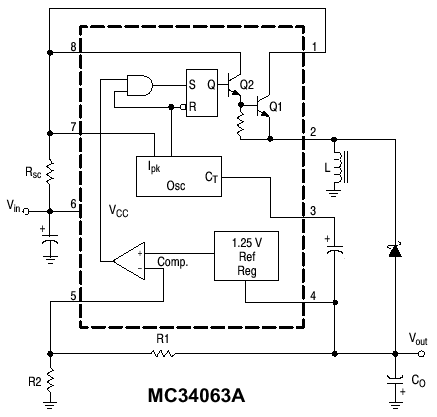MC34063A switching regulator experience
Some time ago when I was looking for a suitable power supply for
our relay board, my eye stopped on MC34063A switching regulator.
The MC34063A is considered rather an obsolete part however what makes it really interesting is its price.
For less than $1 you get complete +5V/0.5A switching power supply controller and
the only thing that you need to do in order to build a step down converter is to add a coil,
diode, three resistors and three capacitors. And this is exactly what I did.

These parts were used in testbed:
CO = LOW ESR C 1000u/6.3V
CIn = LOW ESR C 100u/35V
L = Talema 68uH/1A (too low inductance, see below)
Rsc = 0.39R
R1 = 3k
R2 = 1k
Ct = 470pF
D = 1N5819
Vin = 12V
Vout = 5V
load = 20mA
The first test looked good so it was the time
to check if parameters of the circuity were within designed constraints.
I connected 250MHz oscilloscope to the output leads, set scope timebase, voltage
and such, then switched the regulator on. I saw something that I didn't expect. Pulses with period
330 us and amplitude almost 200mV:

Zoom of the peak:

More zoom (frequency around 90MHz):

Something was not right, but a simple trick with ceramic capacitor did its job.
Connecting a 1nF capacitor directly to pin 4 and 6 made the "black cloudy thing" on the screen disappear.
But there were still significant transients at the output
(pictured below, test leads were connected to input and output capacitors C1=CO, C2=Cin).

Zoom:

More:

Due to low inductance of the coil and low output load (20mA), the MC34063A worked in non-continuous mode.
Increasing inductance to 220uH/1A almost cleaned out the trace:
C1 = output capacitor, channel set to 100mV/DIV. C2 = voltage on diode, channel set to 4V/DIV.

350mA load (zoomed):

Note that there are still some transients here (orange trace). If this is
an issue, there is still a possibility to add an output low pass filter.
Conclusion.
For simple applications with relatively low output currents and where the switching noise doesn't matter
the MC34063A does its job well. Using that switching regulator instead of linear one allows powering
the whole circuity with relatively wide range of voltage along with keeping heat away.
© 2004 michal at vanka dot net








